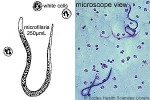Cook Islands Biodiversity Database
Species Page
Wuchereria bancrofti
Filarial Worm
Multimedia & Additional Resources
| Type | Description | Download |
| Microfilaria - illustration and under microscope | 50KB | |
| Microfilaria - detail | 29KB | |
| Disease of Elephantiasis | 39KB |
General Information
|
COMMON NAMES: Filarial Worm, Non-periodic Filarial Worm |
 |
Cook Islands Distribution
| Southern Group: Present Makatea: Present | ||||||||
RR |
MG |
AT |
MK |
MT |
AK |
PL |
TK |
MN |
+ |
+ |
+ |
+ |
+ |
+ |
|||
| Northern Group: Present | |||||
TN |
MH |
RK |
PK |
NS |
SW |
P |
|||||
Pests & Hosts
| Relationship | Hosts |
| Pathogen | Homo sapiens, |
Scientific Taxonomy
Wuchereria bancrofti (Cobbold, 1877)
SYNONYMS: Filaria bancrofti; Wuchereria bancrofti var. pacifica
TAXONOMY: ANIMALIA; NEMATODA; SECERNENTEA (=Phasmidia); Spirurida; Filarioidea; FILARIIDAE
More Information
SIGNIFICANCE NOTES -
NEGATIVE SIGNIFICANCE: Disease causing - serious. Comments: The most serious disease in pre-European Contact times in Eastern Polynesia. It was spread by the Polynesian Mosquito Aedes polynesiensis. The disease remained serious in the post-Contact period. Mass medication and mosquito control around dwellings made it a rare disease by the 1980s, and it was essentially eliminated by early 2000.
The mosquitoes transmit infective larvae to people when they suck blood. The larvae settle into the lymph nodes and grow into slender worms. The worms breed and produce microfilaria (=embryo-worms). Mosquitoes suck up some microfilaria with their blood-meal, and they develop into infective larvae inside the mosquito. Most microfilaria are not taken by mosquitoes and when they die and disintegrate they release toxins causing the fever and rashes associated with the disease Filariasis.
As mosquitoes deliver more infective larvae to a person more and more worms accumulate in the lymph nodes until they are blocked and the limbs become swollen with lymph fluid. This condition is known as Elephantiasis or Big Limbs.
Vouchers & References
Vouchers:
Pukapuka: reported by Dr Steve Kennier, 1980s, as very common, of 300 surveyed 60 (22%) had microfilaria, 12 had hydrocoele, and 5 gross symptoms.
References:
None recorded.
Data Update History (information):
zTX, zB02, zM05a
Web Resources
Citation Information
McCormack, Gerald (2007) Cook Islands Biodiversity Database, Version 2007.2. Cook Islands Natural Heritage Trust, Rarotonga. Online at http://cookislands.bishopmuseum.org. ![]()
Please refer to our use policy.
